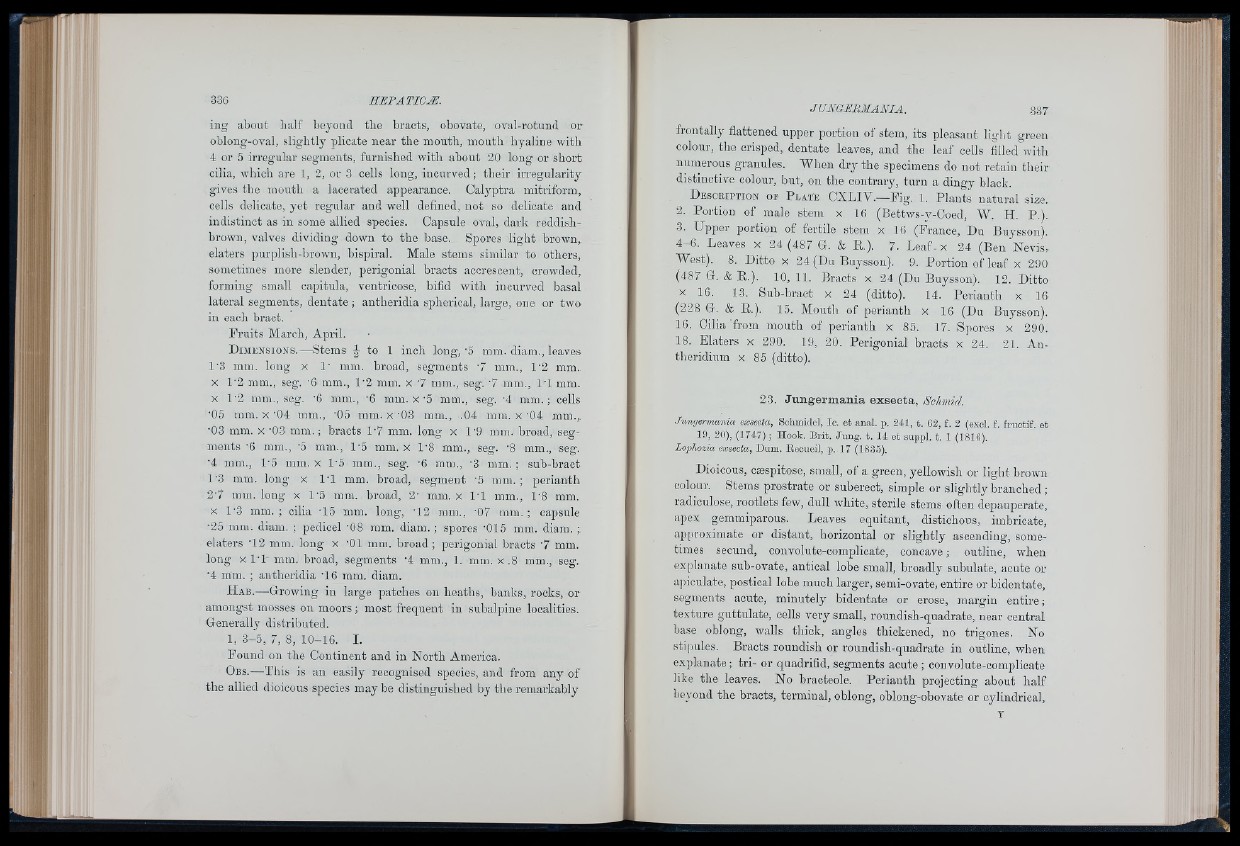
ing about balf beyond tbe bracts, obovate, oval-rotund or
oblong-oval, slightly plicate near the mouth, mouth hyaline with
4 or 5 irregular segments, furnished with about 20 long or short
cilia, which are 1, 2, or 3 cells long, incurved; their irregularity
gives the mouth a lacerated appearance. Calyptra mitriform,
cells delicate, yet regular and well defined, not so delicate and
indistinct as in some allied species. Capsule oval, dark reddish-
brown, valves dividing down to the base. Spores light brown,
elaters purplish-brown, hispiral. Male stems similar to others,
sometimes more slender, perigonial bracts accrescent, crowded,
forming small capitula, ventricose, bifid with incurved basal
lateral segments, dentate ; antheridia spherical, large, one or two
in each braot.
Fruits March, April.
D imensions.—Stems to 1 inch long, ’5 mm. diam., leaves
1'3 mm. long x 1' mm. broad, segments '7 mm., 1'2 mm.
x 1'2 mm., seg. '6 mm., 1'2 mm. x '7 mm., seg. ’7 mm., I 'l mm.
X 1'2 mm., seg, A mm., A mm. x '5 mm., seg. '4 mm.; cells
•05 mm. X '04 mm., '05 mm. x '03 mm., .04 mm. x '04 mm.,
•03 mm. x '03 mm,; bracts 1'7 mm. long x 1'9 mm. broad, segments
'6 mm., '5 mm., 1'5 mm. x 1'8 mm., seg. '8 mm., seg.
'4 mm., 1'5 mm, x 1'5 mm., seg. '6 mm., '3 mm. ; sub-bract
1'3 mm. long x I 'l mm. broad, segment '5 mm. ; perianth
2'7 min. long x 1'5 mm. broad, 2' mm. x I 'l mm., 1'8 mm.
x 1'3 mm.; cilia '15 mm. long, '12 mm., '07 mm.; capsule
'25 mm. diam. ; pedicel '08 mm. diam. ; spores '015 mm. diam. ;
elaters '12 mm. long x '01 mm. broad ; perigonial bracts '7 mm.
long X I 'l mm. broad, segments '4 mm., 1. mm. x .8 mm., seg.
'4 mm. ; antheridia '16 mm. diam.
H ab.—Growing in large patches on heaths, banks, rocks, or
amongst mosses on moors; most frequent in subalpine localities.
Generally distributed.
1, 3-5, 7, 8, 10-16. I.
Found on the Continent and in North America.
O b s.—This is an easily recognised species, and from any of
the allied dioicous species maybe distinguished by the remarkably
frontally flattened upper portion of stem, its pleasant light green
colour, the crisped, dentate leaves, and the leaf cells filled with
numerous granules. Wlien dry the specimens do not retain their
distinctive colour, but, on the contrary, turn a dingy black.
D escription of P late CXLIV.—Fig. I. Plants natural size.
2. Portion of male stem x 16 (Bettws-v-Coed, W. H. P.).
3. Upper portiou of fertile stem x 16 (France, Du Buysson).
4-6. Leaves x 24 (487 G. & E ). 7. Leaf, x 24 (Ben Nevis,
West). 8. Ditto X 24 (Du Buysson). 9. Portion of leaf x 290
(487 G. &E.). 10, 11. Bracts x 24 (Du Buysson). 12. Ditto
X 16. 13. Sub-braot x 24 (ditto). 14. Perianth x 16
(228 G. & E.). 15. Moutli of periantli x 16 (Du Buysson).
16. C ilia ’from mouth of perianth x 85. 17. Spores x 290.
18. Elaters x 290. 19, 20. Perigonial bracts x 24. 21. Antheridium
x 85 (ditto).
23. Ju n g e rm an ia exseota, Schmid.
.hmjermania exseota, Schmidel, Ic. e t anal. p. 241, t. 62, f. 2 (excl. f. fructif. e t
li), 20), (1747) ; Hook. Bi-it. Ju n g . t. 14 et suppl. t. 1 (1816),
Lophozia exsecta, Bum. Recueil, p. 17 (1835).
Dioicous, cæspitose, small, of a green, yellowish or light brown
colour. Stems prostrate or suberect, simple or slightly branched ;
radiculose, rootlets few, dull white, sterile stems often depauperate,
apex gemmiparous. Leaves equitant, distichous, imbrioate,
ap[)roxiniate or distant, horizontal or slightly ascending, sometimes
secund, convolute-complioate, concave ; outline, when
explanate sub-ovate, antical lobe small, broadly subulate, acute or
apiculate, postical lobe much larger, semi-ovate, entire or bidentate,
segments acute, minutely bidentate or erose, margin entire ;
texture guttulate, cells very small, roundish-quadrate, near central
base oblong, walls thick, angles thickened, no trigones. No
stipules. Bracts roundish or roundish-quadrate in outline, when
explanate; tri- or quadrifid, segments acute; convolute-complioate
like tlie leaves. No bracteole. Perianth projecting about half
beyond the bracts, terminal, oblong, oblong-obovate or cylindrical.